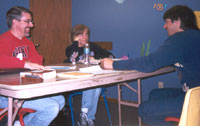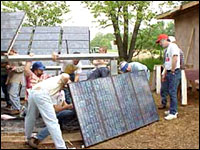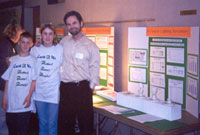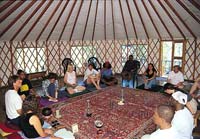Jonna Higgins-Freese is environmental outreach coordinator at Prairiewoods: Franciscan Spirituality Center in Hiawatha, Iowa. She is a fellow of the Environmental Leadership Program.

Monday, 11 Mar 2002
HIAWATHA, Iowa
Just for the record, I am not a nun. I do work for nuns, so folks often want to know if I’m one of them. I usually say that I’m not qualified on two counts: I’m married, and I’m a Quaker.
The place where I work, Prairiewoods: Franciscan Spirituality Center, is one of three spirituality centers owned by the Franciscan Sisters of Perpetual Adoration. Prairiewoods’ mission is to integrate spirituality and ecology into every facet of our operations — from food service to grounds maintenance, from energy production to programming. The sisters believe, along with many other religious women and men across the U.S., that they are called at this time to care for the Earth. Historically, nuns in the U.S. have provided education and health care — crucial needs that no one else was meeting. Now that those are widely available (theoretically), the sisters feel that what’s needed today is a model for ecological living and a voice for the Earth. Prairiewoods is just one part of a broad network of ecological spirituality centers and resources that includes Genesis Farm, Michaela Farm, and Earth Light Magazine.
My role as environmental outreach coordinator here is to assist with some of the on-site ecological projects (particularly our prospective wind turbine installation) and to help other faith groups in the area live out their own commitments to care for creation. That can take some interesting forms; for example, on Saturday morning, my task was wine delivery.
I dropped off two bottles of Tabor Home Winery’s Barn Dance Red wine to be used in the closing communion service at Congregations Together in Ministry (CTIM), an annual conference sponsored by the Evangelical Lutheran Church in America, Southeast Iowa Synod. For about a year, I’ve been working with the synod, several local wineries, and the Leopold Center for Sustainable Agriculture to encourage Christian churches to use locally made wine for communion.
The project began in the summer of 2000, when the Leopold Center published Grape Expectations: A food system perspective on redeveloping the Iowa Grape Industry. The report documented that grapes were an important part of Iowa’s diverse, small farm-based agriculture in the early part of the 20th century: The state ranked sixth in U.S. grape production in 1919. However, as Iowa shifted to corn and soybean production in the 1930s and 1940s, grape production decreased. The corn herbicide 2,4-D, to which grape vines are very sensitive, began drifting into vineyards, and was a key factor in the decline of the grape industry in the Midwest. However, Iowa’s grape and wine industry is growing again as farmers see opportunities to market products that will earn them much more per acre than row crops.
Using local wine is only one way faith communities can show their support of local, sustainable agriculture. We sometimes forget that food is central to many religious traditions: Muslims fast and feast throughout Ramadan; Buddhists and Jains are vegetarian; and the stories of the Judeo-Christian tradition include unleavened bread, manna from heaven, the loaves and the fishes, the Last Supper, and the wedding at Cana. The scriptures are full of stories and teachings supporting small farms: “Woe to those who add house to house and join field to field, until everywhere belongs to them and they are the sole inhabitants of the land” (Isaiah 5:8). Every major denomination has statements supporting rural areas and small farmers. Recently, a Cardinal in Italy even argued that fast food is not appropriate for Catholics, since it destroys the bonds of family and community.
In part due to the outreach program’s encouragement and educational materials, several faith communities in the Cedar Rapids area are supporting local agriculture. More than a dozen church members in the area have been introduced to Community Supported Agriculture (CSA) through presentations at their churches; Prairiewoods serves as a drop-off site for CSA shares for many of those members.
Lutheran Church of the Resurrection in Marion, Iowa, grows a garden on church property. Members sell the produce outside the sanctuary on Sunday mornings, using the proceeds to support Habitat for Humanity and other projects. The mid-week harvest is taken to the food pantry, where clients are excited to have “real food.”

Pastor Karen, with Kale.
Robert Rosenheck.
Olivet Presbyterian church in downtown Cedar Rapids grows a garden to provide fresh vegetables to the many low-income, minority, and refugee families in its neighborhood. Pastor Karen Beals is excited when she looks out her window from the rectory across the street and sees folks she doesn’t know pulling weeds and picking a snack.
Surely, then, the substance that Christians say represents (or is) the blood of Christ should be made in a way that promotes social and environmental justice. Once they stop and think about it, most people understand that. Until then, they’re just out to be “good stewards of their financial resources” — one pastor told me that she’d almost spit out the dregs in the chalice one morning during worship when she discovered that her frugal altar guild had purchased Mad Dog 20/20 for communion instead of the usual Mogen David! So pastors are excited about the theological and social justice reasons to use local Iowa wines — but they’re also glad that the local wines have won awards for quality at international festivals.
More than 20 Iowa churches are now using local wines for communion, and that number may expand again after Saturday’s CTIM service. I’ll have to check in with my contacts at the wineries to see.
In the meantime, I’m off to attend a couple of meetings. The first is a planning meeting for “Ethical Perspectives on the News” a local 30-minute television show sponsored by the Interreligious Council. I’m one of the moderators, and I want to find out who we’ve got for panelists on next week’s show on the ethics of corporate power and the Enron scandal, and advocate for a show one of the other moderators proposed on the Bush administration’s decision to exempt industries from having to pay taxes to the Superfund for cleanup of toxic sites. After that, I’m off to a meeting of Choose Now, a nonprofit organization based at a Wesleyan church here in town. Its members are fired up about building a super-efficient, passive solar Habitat for Humanity house, with renewable energy and efficient appliances, and I need to put them in touch with church folks interested in environmental issues who’ll volunteer.
Tuesday, 12 Mar 2002
HIAWATHA, Iowa
I’ve been doing environmental work with churches in the Cedar Rapids area for almost four years now, and sometimes I feel like a voice crying in the wilderness. While every major Christian denomination has a social statement about the theological importance of caring for creation, not many churches pay much attention.

CHOOSE Now board members Chris Bruns, Kris White, and Phil Beelendorf.
CHOOSE Now.
However, a growing group of people understand environmental concerns to be spiritual and even religious. CHOOSE Now (Christian Outreach Organization to Save the Earth), based at Hillside Wesleyan Church in Cedar Rapids, is one such group. It recently asked me to join the board, and at last night’s meeting we discussed how to design and raise money for the group’s first project: a Habitat for Humanity house that will be super-efficient and perhaps offer some renewable energy features. In addition, it wants to furnish the house with energy-efficient appliances.
I love this project because it brings out the social justice dimension of environmental issues — it will benefit a low-income family that needs energy efficiency the most and usually has the least access to it. Church members already understand and accept Habitat projects, but this one pushes them a little further by showing that super-efficient construction is feasible, affordable, good for the environment, and good for homeowners.
This project arose at the perfect stage in my work. For four years, I’ve been giving presentations to churches and meeting people who care about the environment from a faith perspective. They’ve been joining CSAs, using local wine, switching to non-chemical lawn care, using less energy in the church and at home, and trying to be less consumer-oriented. I’ve been looking for a way to bring them all together around a common, inspiring project, and I think building the Habitat house may be the perfect rallying point.

Workshop members connect solar panel circuits.
I-Renew.
CHOOSE Now’s work also fits right in with Prairiewoods’ philosophy that we should live the change we want to create. Prariewoods features solar hot water in the guest house, a Trombe wall at the sisters’ residence, earth berming, and super-efficient insulation throughout. Two years ago, we built two new hermitage buildings for our guests who want a solitary retreat. With the help of the Iowa Renewable Energy Association (I-Renew), we held hands-on workshops where people learned about straw bale construction and photovoltaic installation. Now, about 85 people each year learn how happy they can be in a straw-bale building with radiant floor heating, passive solar design, off-grid electricity, and a constructed wetland sewage system.
Our next project is to install a wind turbine, and my task for the day is to research answers to a series of questions about the project from the operating board. I also need to call Alliant Energy to begin negotiating our net metering arrangement; with net metering, we’ll remain connected to the grid and buy energy from the utility when we need it. When the wind blows, our meter will run backward. At the end of the month, we pay our bill, or the utility pays us. Typically, utilities prefer that the customer pay retail for electricity used, but receive only the “avoided generation cost” (much less than retail) for what they produce.
Yesterday, the Iowa Utilities Board required MidAmerican Energy to pay customers retail, so I’m thinking it’s a good day to begin our talks with Alliant. They’ve installed several wind farms and offer a green electricity program called Second Nature, so I feel pretty confident that we can come to a good arrangement with them. Besides, I can’t imagine they want the PR nightmare of preventing a bunch of “sweet little nuns” from doing what’s good for the environment.
Wednesday, 13 Mar 2002
HIAWATHA, Iowa
This week took an interesting turn for me when an ongoing debate within Prairiewoods about how best to do our environmental work heated up. It’s the time of year when we start going over our budget — and number-crunching always lends an edge to theoretical debates about what we should do and how we should do it.
As I said yesterday, Prairiewoods already does a great job of modeling a number of environmental practices, and we provide a space where people can connect with the sacred through nature. But the organization faces some challenging decisions: Is it appropriate for us to move from inner (private) communion with nature to outer (political) action to protect it? Should we move beyond demonstrations and “consciousness raising,” as the Outreach Program does? Are personal behavior and political advocacy central to our work as a spirituality center?
These questions highlight some of the important challenges facing the faith-based environmental movement today. On the one hand, some secular environmentalists are skeptical of the value of working with churches or using spiritual language in the struggle to protect the Earth. They’re concerned — and rightly so — that organized religion has been responsible for a lot of pain and suffering in the world, and some may have experienced this pain and suffering personally.
On the other hand, most religious people don’t see the environment as central to their faith. Thus the movement’s first task was to make the case that environmentalism is a legitimate and appropriate concern for people of faith. These days, there is a vast body of literature on the relationship between spirituality and ecology. Cal DeWitt has re-read scripture from an ecological perspective. Matthew Fox and others have reclaimed St. Francis and the Christian mystics, including Julian of Norwich and Hildegard of Bingen. Elizabeth Johnson, Sallie McFague, Gordon Kaufman, and Rosemary Radford Reuther have reconstructed theology wholesale to address our current environmental situation. Thomas Berry and Brian Swimme have incorporated new scientific understandings into the traditional creation stories.
The theological work is mostly done; now the challenge is to integrate that work more widely and deeply into faith practice. I find that people of faith are generally quite open to these new theological arguments. But, like most of us, they become uncomfortable when they’re pushed further and asked to make a change or take a stand. The problem is that religion, when it’s functioning well, is about taking a stand for an alternative vision of the good life.
Happily, the movement is heading slowly in that direction. For example, the Interfaith Climate Campaign began by educating people of faith about the issues surrounding global climate change, but is now mobilizing them to contact their senators to ask for better energy policy. (More on that tomorrow.)
But many people are still more comfortable with “private” spiritualities, so Prairiewoods is wrestling with tough questions: Is it enough to provide a place where people can sense the sacred in nature while hiking our trails, walking the outdoor labyrinth, and watching the deer and goldfinches? Do we conduct general “environmental education” and hope that people will be moved to learn more and take action? Or do we also challenge people to make real changes in their lives, provide specific information on where they can buy local foods or compact fluorescent light bulbs, and then support them as they change? Do we run savvy media campaigns and focused political advocacy drives?
As for me, I’m convinced that if religious and spiritual people want to be taken seriously in the environmental arena, personal action and political activism will have to become as indispensable to the spiritual life as prayer. As Paul Gorman, director of the National Religious Partnership for the Environment, says, “Care for creation and the work of environmental sustainability and justice must become central to what it means, now and henceforth, to be religious.”
Thursday, 14 Mar 2002
HIAWATHA, Iowa
This has been a big week for our work with the Interfaith Climate Campaign. The Iowa Campaign has been active for three years, and we’re now coordinating our efforts with campaigns in 20 others states.
As part of our own campaign, we sent emails to religious people throughout the state who’ve expressed interest in environmental issues. We asked them to call Iowa Sens. Charles Grassley (R) and Tom Harkin (D) to request that they raise the Corporate Average Fuel Efficiency standards and set a 20 percent renewable portfolio standard (which ensures that some of the nation’s power comes from renewable resources like wind and solar energy). Sadly, last night the Senate voted against raising CAFE standards.
This is the first time I’ve been actively involved in trying to affect legislation, and I’m a little surprised by how sad I feel about the loss. We worked so hard on this, and it’s disappointing that we weren’t successful.
Last month, more than a thousand religious leaders nationwide signed a letter to the Senate outlining the moral and ethical dimensions of climate change and asking for several specific energy policies: no drilling in the Arctic National Wildlife Refuge, strong CAFE standards, the 20 percent renewable portfolio standard, and more funding for the low-income heating assistance program.
In Iowa, we got 19 leaders to sign the letter, including Episcopalians, Disciples of Christ, Presbyterians, Lutherans, Baptists, and Catholics. The national campaign is coordinated by the National Religious Partnership for the Environment, the National Council of Churches Eco-Justice Working Group, and the Coalition on Environment and Jewish Life. In Iowa, we also got signatures from Buddhists and the Inter-Religious Council of Linn County, which includes Muslims, Jews, Christians, Buddhists, Hindus, Baha’is, and Unitarians.
Later today I’ll meet with my co-coordinator on this project, Bob Gronski, who works for the National Catholic Rural Life Conference. We need to debrief, figure out the next steps in the project, and go over our budget.
For the past three years, Iowa’s Climate Campaign has been supported by the W. Alton Jones Foundation. When the foundation restructured, we were left with only funding from the Pew Charitable Trust for our advocacy work — not enough to continue the basic education and energy-efficiency programs, which is where we have historically found people interested in being advocates.
In order to motivate Iowa’s Bishops, Head Presbyters, and other religious leaders to increase their commitment to the project and support it with their own resources, we decided to invite them to a seminar with a high profile speaker — environmental advocate and author Bill McKibben. The event is April 12, and I need to go over some details today with the Rev. Ben Webb, who is helping us put this event together using his contacts as the author of Fugitive Faith: Conversations on Spiritual, Environmental, and Community Renewal
I also need to check in with Cathy Livingston, a volunteer who presented her first climate change workshop to a church last weekend. We’ve given more than 50 of these workshops at churches across the state in the past few years. After showing a short video outlining the science of climate change and the reasons faith communities are concerned about caring for creation and promoting justice, we ask the church to implement a number of energy conservation and efficiency practices within the facility, and to encourage members to take similar steps at home.

Matt Schulz — and kids — with the lighting display.
Karla Sibert.
Some churches have done impressive work. Matt Schulz, who’s a member of the Zion Environmental Stewardship Team at Zion Lutheran in Iowa City, put together a terrific display called “Energy Efficiency is Good Stewardship” to show that compact fluorescent lighting looks great and saves money.
Harry Manhart, the custodian at St. Pius X School in Cedar Rapids, replaced all of the building’s incandescent exit sign lights with LED strips, installed more efficient fluorescent lights, and converted to longer-lasting, greener lighting in the gym.
I’m always inspired by Bob, Ben, Cathy, Matt, Harry, and all of the people who feel called upon to care for creation. They help me get through setbacks, like the Senate not passing higher CAFE standards. They help me remember that, while we have to be as effective and strategic as possible in our work, our efforts are part of a larger power — whether we call it God, spirit, the divine, the universe, or nothing at all. We’re not required to be successful; we’re only asked to be faithful to the task.
Friday, 15 Mar 2002
HIAWATHA, Iowa
Thank God it’s Friday. I love my work, and I feel lucky to be able to spend my days in this beautiful setting, but enough is enough.
I find it hard to simplify my time commitments, even though part of my job is to give presentations and convene study circles on voluntary simplicity and conscious living. Every week, I share with others great resources on these topics, such as Simpler Living, Compassionate Life: A Christian Perspective and materials developed by the Center for a New American Dream and the Northwest Earth Institute.
Still, I find that on the rare Sunday mornings that I’m not giving a presentation in someone else’s church, I’m often too exhausted to attend my own Quaker meeting. While I’m persuading others to join CSAs and shop at farmers markets, the fresh produce from my own CSA share is wilting in the box, unused.

Meditating at Vallecitos Mountain Refuge.
I’m especially conscious of the fragmented and unmindful ways I often spend my time because I just came back from a week’s retreat at Vallecitos Mountain Refuge, a wilderness ranch and contemplative retreat center located in the Rocky Mountains of northern New Mexico. Vallecitos recognizes that contemplative awareness, personal growth, and spiritual development all contribute to the efficacy of nonprofit leaders and organizations. For five days, I spent the mornings meditating and the afternoons exploring the retreat center and nearby Carson National Forest on snowshoes and skis.
Tacked onto the bulletin board outside Vallecitos’ meditation hall is a quote from Trappist monk Thomas Merton that sums up the need for activists in particular to seek quiet and rest:
There is a pervasive form of contemporary violence … [and that is] activism and overwork. The rush and pressure of modern life are a form, perhaps the most common form, of its innate violence.
To allow oneself to be carried away by a multitude of conflicting concerns, to surrender to too many demands, to commit oneself to too many projects, to want to help everyone in everything, is to succumb to violence.
The frenzy of our activism neutralizes our work for peace. It destroys our own inner capacity for peace. It destroys the fruitfulness of our own work, because it kills the root of inner wisdom which makes work fruitful.
Wayne Muller, founder of Bread for the Journey, is more direct. In Sabbath: Finding Rest, Renewal, and Delight in our Busy Lives, he writes:
Our lack of rest and reflection is not just a personal affliction. It colors the way we build and sustain community, it dictates the way we respond to suffering, and it shapes the ways in which we seek peace and healing in the world … [Because we do not rest], the way problems are solved is [usually] frantically, desperately, reactively, and badly.
One of the gifts religious and spiritual practice offers to the environmental movement is this recognition of the importance of rest, reflection, and being. The Buddhist tradition speaks in terms of meditation and mindfulness, a state of inner peace and happiness that is available to us in each moment. The Jewish and Christian traditions offer the Sabbath. Although Sabbath has sometimes been practiced, especially by Protestants, as a dreary time when strict rules prohibited any joy or fun, the gospel of Mark specifically says: “You are not made for the Sabbath; the Sabbath is made for you.”

Prairiewoods trails.
Wayne Muller argues that Sabbath is any time we use for sacred rest, whether it’s a day, an hour, a walk, or a single breath. Behind the traditional rules and prohibitions of the Sabbath is “an idea that by saying no to making some things happen, deep permission arises for other things to happen. When we cease our daily labor, other things — love, friendship, prayer, touch, singing, rest — can be born in the space created by our rest. Walking with a friend, reciting a prayer, caring for children, sharing bread and wine with family and neighbors — those are intimate graces that need precious time and attention.”
With all that in mind, I think it’s time to stop so I can hike one of Prairiewoods’ trails before lunch. I’ve been so busy doing environmental work, I haven’t been down to the creek in weeks. I’ll end this week with an appropriate quote from Edward Abbey, who sums things up better than I could:
One final paragraph of advice: Do not burn yourself out. Be as I am — a reluctant enthusiast … a part time crusader, a half-hearted fanatic. Save the other half of yourselves and your lives for pleasure and adventure.

